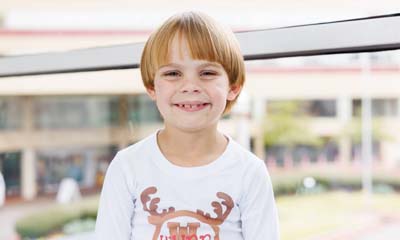Eosinophilic Esophagitis (EoE)
After their daughter, Collins, was born with digestive issues, Leah and Brandon Arkle thought they were prepared when son Wynn arrived and started showing symptoms. But it wasn’t long before they realized something was simply different with Wynn. “We began noticing excessive crying and excessive spit up no matter what we did,” Leah says. “We were really thrown through a loop.”
The problem got so bad so quickly for Wynn that as an infant he developed a food aversion, getting upset at just the sight of a cup, spoon, or even a pacifier. Even after trying various medications, nothing seemed to help. Their local pediatrician in Dothan referred Wynn to Children’s of Alabama, where testing eventually revealed he had eosinophilic esophagitis (EoE), an autoimmune disease that affects the digestive system. “We found out that he had so many eosinophils that had grown, he literally couldn’t digest solid food,” Leah adds. “It was that bad.”
Having also been diagnosed as failure to thrive, Wynn had a nasal gastric feeding tube inserted, but doctors felt that the only solution was for Wynn to be enrolled in the Children’s Intensive Feeding Program. “It’s hard to get into because only three families can be admitted at a time, but his doctors knew he needed it and quickly got the program director into our hospital room to see Wynn,” Leah says. “She came in, saw Wynn, talked to the doctors, and she immediately pushed him to the top of the list.”
In order to participate in the program, Leah and Wynn had to move to Birmingham for three months. They got an apartment nearby through Red Mountain Grace and spent every day at Children’s. During the program, Leah and Wynn had access to occupational therapy and speech therapy, along with guidance from a dietician, a psychologist and a team of gastroenterologists, all of whom put together a plan to rid Wynn of his food aversion and help Leah learn how to feed him—a tough task considering his refusal to eat and the number of foods to which he is allergic. “It sounds simple to make happen, but for a child that doesn’t want to eat, it’s a very difficult process for a very long time,” Leah says. “At first, I didn’t know if I could do it. It’s hard seeing your child going through it, and you don’t know how to help him.”
The team worked with Wynn and Leah every day. They provided Leah with specific details on how to prepare food for him and how to feed him, even giving her recipes and making sure she had the right tools and utensils at home. “Eventually, when it got near the end of the program, I was like, ‘OK, we can do this,” she says. “He’s actually eating, and I just couldn’t believe it.”
In addition to taking care of Wynn’s medical needs, Leah also appreciated how Children’s took care of both of their physical, mental, and emotional needs. There were always activities on the calendar in which they could partake, such as a magician coming in and all the activities going on at Children’s Harbor. “We were in a situation that could have been so emotionally and physically taxing and terrible, but Children’s took care of us,” Leah says. “All of those little details made such an impact—things as small as just giving us things to look forward to. I felt like they were invested in both of us, making sure we were both OK.”
Wynn completed the program. He went home actually eating, having his tube feedings reduced and even at a healthy weight. A few years later—just before his sixth birthday—Wynn was even able to have the feeding tube removed. Though he still makes frequent check-up visits to Children’s—and there is always the chance he will eventually need the feeding tube again—the family is simply enjoying the progress Wynn has made and the ever-present care Wynn gets at Children’s. “I’m so proud of Wynn—he has a heart of gold and an attitude that will never give up,” Leah says. “It hasn’t been easy, but I can’t say enough about what Children’s has done for us. Thanks to Children’s, I’ve felt hope, and I’ve seen progress in Wynn. We’re just taking it all a day at a time, and that’s much easier to do with all of the help we get with Children’s.”







